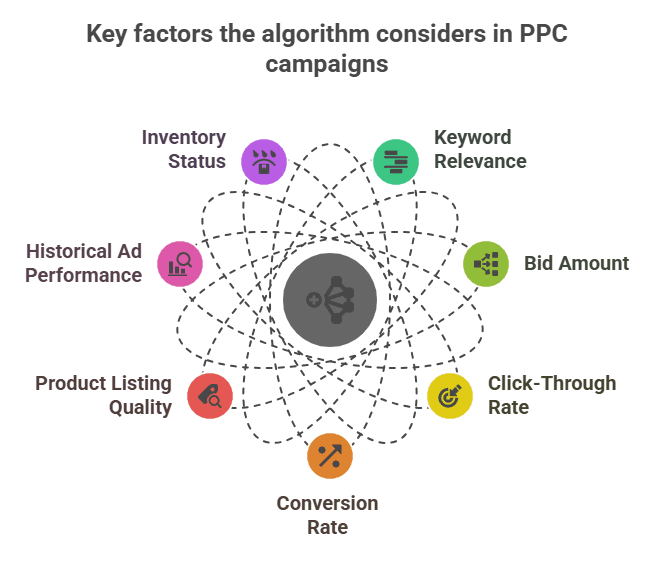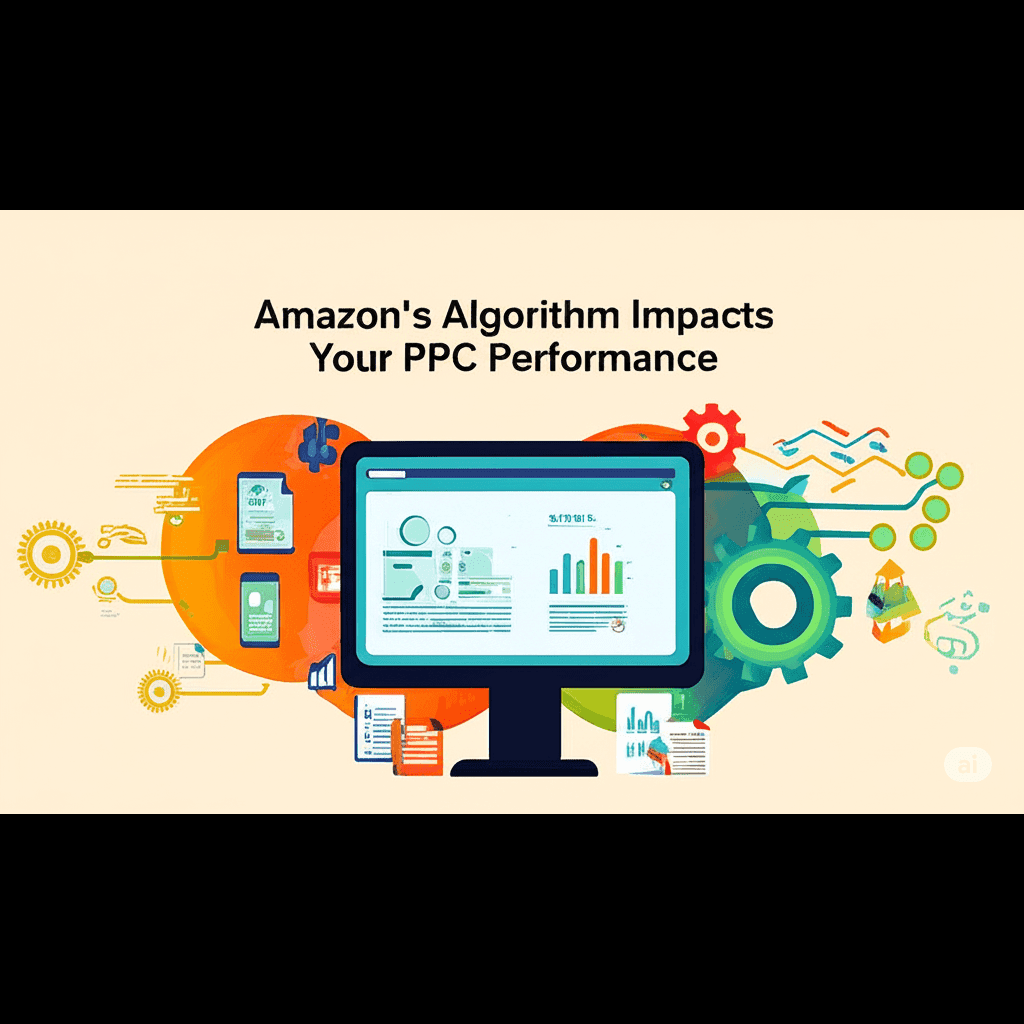Amazon PPC
TL;DR
Amazon’s A9 algorithm affects both organic rankings and PPC ad performance based on data like keywords, CTR, conversion rates, and product relevance.
Strong product listings with the right keywords, images, pricing, and reviews help improve both paid and organic visibility.
A successful PPC campaign can boost your organic ranking by increasing sales velocity and keyword relevance.
Key factors for ad success include CTR, conversion rate, bidding strategy, and past performance history.
Align your ads with the algorithm by using relevant keywords, optimizing listings, and targeting the right audience.
Amazon PPC consultants can help you build a smart, data-driven strategy that improves results and lowers ad spend.
Did you know that Amazon’s search algorithm, known as A9, doesn’t just affect your organic rankings, but also plays a huge role in your PPC ad performance?
Many sellers run ads without understanding how the algorithm works, and as a result, they overspend or miss out on better placements. Amazon’s algorithm decides which products appear in search results and which ads show up where and it's all based on data. It looks at your keywords, click-through rate (CTR), conversion rate, product relevance, and even your bidding strategy.
So if your listing isn’t optimized or your targeting is off, your ads may underperform no matter how much you spend. In this blog, we’ll break down how the A9 algorithm works, how it impacts your Amazon PPC performance, and what you can do to align your ads with it. Understanding the algorithm is key to making smarter ad decisions and boosting your results.
Understanding Amazon’s A9 algorithm
Amazon’s A9 algorithm is the engine behind how products are ranked and shown in search results. It’s designed to show shoppers the most relevant and likely-to-sell products based on their search terms. While many sellers focus on paid ads, it’s important to know that A9 affects both organic rankings and PPC performance.

The algorithm looks at multiple signals like product relevance, conversion rates, click-through rates (CTR), and sales history to decide where your product or ad appears. The more data Amazon has that shows your product performs well for certain keywords, the more likely it is to rank higher both in organic and sponsored results.
A9 rewards listings that match shopper intent and convert. That means if your listing has the right keywords, strong images, competitive pricing, and good reviews, you’re more likely to win better placements even without increasing your ad spend. Understanding A9 helps you run ads that work.
How does the algorithm rank products in search results?
Amazon’s A9 algorithm ranks products in search results based on how relevant and likely they are to convert into a sale. It doesn’t just look at what the shopper searched for, it analyzes how well your product has performed for that search term in the past. The goal is to show shoppers products they’re most likely to buy.
Key factors that influence ranking include relevancy of keywords, product title, bullet points, and backend search terms. But it’s not just about keywords. The algorithm also considers sales history, pricing, availability, customer reviews, and shipping speed (like Prime eligibility).
If your product converts well and gets clicked often for a certain keyword, Amazon will rank it higher. That’s why your product listing and ad strategy need to work together. The better your product matches what the shopper wants and proves it through performance, the better chance it has to appear at the top of search results.
The relationship between organic ranking and PPC performance
Amazon product ranking and PPC performance are closely connected and often influence each other. When you run a successful PPC campaign, it doesn’t just help you get paid visibility, it can also improve your organic ranking over time. That’s because Amazon’s algorithm looks at factors like sales velocity, click-through rate (CTR), and conversion rate to decide which products to show higher in both paid and organic search results.
When a product gets more sales through ads, Amazon sees it as popular and relevant for the keywords it’s being advertised for. This can lead to your product climbing up the organic search results for those same keywords even when you’re not running ads.
On the other hand, having a strong organic rank can also improve your ad performance. When your product is already trusted and well-reviewed, shoppers are more likely to click and buy even when it appears as a sponsored result.
In short, PPC helps drive traffic and sales, and those sales help boost your organic rank. At the same time, good organic performance helps your ads convert better. When both work together, you can grow visibility, lower ACoS, and build long-term success on Amazon.
Key factors the algorithm considers in PPC campaigns
When you run Amazon product display ads, their internal PPC (Pay-Per-Click) algorithm decides when and where your ads appear. Understanding how this algorithm works can help you improve ad visibility, lower costs, and increase sales. Here are the key factors Amazon considers when ranking your ads:

1. Keyword relevance
Relevance is one of the most important signals. Amazon checks how well your selected keywords match a shopper’s search query. If your ad is tightly aligned with what the customer is searching for, it’s more likely to be shown. This includes keyword match type (broad, phrase, exact) and how closely the search intent matches your product. You can also choose keyword research services that help you with a data-driven keyword strategy.
2. Bid amount
Your bid sets the maximum you’re willing to pay for a click. While higher bids can increase your chances of winning ad placements, Amazon doesn’t prioritize bids alone. A lower bid with high relevance and performance can still beat out a higher bid if the ad is more likely to convert.
3. Click-through rate (CTR)
Click-through rate (CTR) measures how often people click on your ad after seeing it, and it’s one of the most important performance indicators in Amazon advertising. A high CTR means that your ad is grabbing attention, and it signals to Amazon that your creative, headline, and targeting are relevant to shoppers. When Amazon sees a strong CTR, it assumes your ad is more likely to lead to a sale, which aligns with their goal of delivering a better shopping experience.
4. Conversion rate
When someone clicks on your ad, Amazon checks how often that click leads to a sale. This is called the conversion rate. If your ad brings in sales often, Amazon sees it as a good ad and shows it to more people. That means your product gets better spots in search results and on product pages. More people see your ad, and you can get more sales without spending more. A high conversion rate can also lower your cost per click. To improve it, make sure your listing has clear images, good reviews, fair pricing, and the right keywords.
5. Product listing quality
Your Amazon product ads are only as strong as the product page they link to. Listings with clear, high-quality images, compelling titles, bullet points, competitive pricing, and positive reviews are more likely to perform well. Amazon’s algorithm takes this into account when assessing your ad’s overall value.
6. Historical ad performance
The algorithm also uses past performance data to predict future results. If your campaigns have consistently performed well, driving clicks, sales, and maintaining a healthy ACoS, Amazon sees them as “safe bets” and continues to promote them more aggressively.
7. Inventory status
If your product is low on stock or frequently goes out of stock, your ad ranking can drop. Amazon wants to promote products that are readily available to ship and deliver quickly. By understanding and optimizing for these factors, you can create stronger Amazon PPC campaigns that not only perform better but also cost less over time.
Tips to align your PPC strategy with Amazon’s algorithm
Use keywords that match what shoppers are searching for
Write clear product titles and bullet points
Add good-quality images to your listings
Try to get more clicks and sales from your ads
Pick a bidding strategy that fits your goal
Test different ads to see what works best
Use negative keywords to block unwanted clicks
Target both branded and non-branded keywords
Keep your products in stock
Use your best keywords in both ads and product listings
Common mistakes sellers make when ignoring the algorithm
Using the wrong keywords that don’t match what people search for
Not fixing product titles, descriptions, or images
Running ads that don’t get many clicks or sales
Setting bids too high or too low without checking results
Ignoring important numbers like ACoS and CTR
Putting too many unrelated keywords in one ad campaign
Not updating listings based on what’s working
Forgetting to use negative keywords to block bad clicks
Letting your product go out of stock
Only focusing on ads and not improving your product page
Final words
Understanding how Amazon’s A9 algorithm works is key to improving your PPC ad performance. From keyword relevance and listing quality to bidding strategy and conversion rates, every detail matters. If your ads and listings align with what Amazon’s algorithm values, you’ll see better placements, lower costs, and higher sales.
But getting it right can take time, testing, and expertise. That’s where Amazon PPC consultants come in. They can help you fine-tune your campaigns, avoid common mistakes, and build a strategy that works with the algorithm, not against it. With the right support, you’ll spend smarter and grow faster on Amazon.









